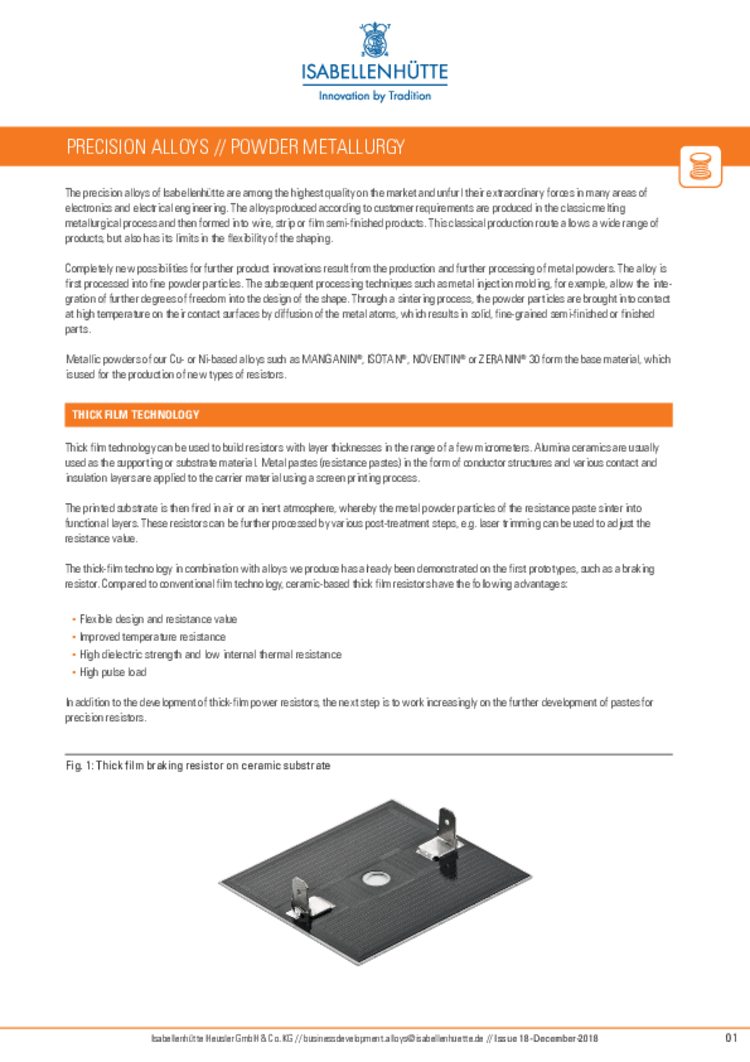Products such as wire, strip or foil are usually melted at Isabellenhütte using conventional melting metallurgical processes and then converted into semifinished products. On the other hand, powder metallurgy describes a field of metallurgy that deals with the production and further processing of metal powders.
While the metal or the alloy is first converted into the liquid state in melting metallurgy and the solidification then takes place afterwards, the powder particles are brought together at their contact surfaces at high temperatures by diffusion of the metal atoms, also referred to as sintering, resulting in a solid, fine-grained semi-finished product or finished product. In metals, the sintering temperature is in the range from 65 and 80% of the melting temperature.
Various production processes are used to produce powder particles, such as inert gas atomization, mechanical methods or chemical reduction. Metallic powder from our Cu or Ni base alloys, such as Manganin®, Isotan®, Isaohm®, Noventin® or Zeranin® 30, are the starting point for a number of our manufacturing technologies that are relevant for the future. These come from the field of printed electronics, such as thick film technology where metal-filled resistance pastes are processed, thin film technology where metallic inks are used, metal injection molding as well as additive production or 3D printing.
Thick Film Hybrid Technology
Thick film hybrid technology is an assembly and joining technology for producing electronic circuits in integrated and discrete designs. Thick film technology can be used to construct integrated or discreet resistors with film thicknesses in the range of a few micrometers. Plates made of alumina ceramic are usually used as the supporting or substrate material. The conductive tracks are applied in the screen or stencil printing process via metal pastes and provided with insulation layers. The printed substrate is fired in the air or in an inert atmosphere. In the process, the powder components of the resistance paste sinter into functional layers. The electrical resistance can be subjected to a precision adjustment in a subsequent laser trimming step.
Thin Film Process
Similar to the thick film technology, thin film processes can also be used to apply metallic functional layers, which are also part of printed electronics. The functional layers are applied by means of metallic inks, are hardened and fired or sintered. Typical film thicknesses are in the range of a few micrometers to nanometers.
MIM - Metal Injection Molding
Metal injection molding or MIM is a process for producing metallic components with complex geometries. It has its origin in plastic injection molding technology. Metals can be processed using conventional methods of casting and machining much more heavily than plastics. MIM combines the simplicity of molding in injection molding with the material properties of metal. For this purpose, metal powder is mixed with an organic binder to form a so-called feedstock and is shaped on an injection molding machine. Then the binder is removed and the component is sintered in a furnace at a high temperature.
The result is a metallic end product that combines the mechanical advantages of sintered components with the molding diversity of injection molding. In this way, components with sophisticated geometries can be made in a single piece, which can only be produced in several stages in conventional processes.
Additive methods of 3D printing can be used to generate components from metallic powders in a layer-by-layer manner. This production method has already been established for several years in the development and construction sector as part of rapid prototyping, but is also increasingly being used in series production. A key advantage of this process is that highly complex structures can be produced by using a strong laser beam to melt the powder precisely at the points that are predetermined by computer-generated design data. Then the production platform lowers and another application of powder occurs. The material is re-melted and joins with the underlying layer at the defined points.

